Analysis of collected digital practices in HME institutions
by Enric Guaus and the members of the SMS Digitisation Working Group.
Introduction
In a previous post, we – as the Digitisation Working Group – described the collected data from a questionnaire presented in September 2019, including a non-exhaustive list of the digitisation practices that were carried out by professors and administrative staff from HME (Higher Music Education) institutions affiliated to the AEC (European Association of Conservatoires).
We also detailed the sets of labels respondents had to select for categorising their practices according to three different criteria: its social role, its access and its function in the institution.
Far from presenting a list of “good practices” from the collected data, this article shows the result of this categorisation process with the aim of presenting an overall picture about the topics or strategies frequently covered by professors and administrative staff as well as visualising which areas are not covered and need particular attention for development.
The post is organised as follows: first, we present a brief summary of the collected data. Then, we show the label histograms within each set and an inter-set analysis by using a 3D-cube to explore more interesting relationships. Finally, we discuss the findings and provide some final conclusions.
Participation


The questionnaire was launched in September 2019 and it is still open to new answers. Nevertheless, most of the proposals were received before the COVID-19 pandemic spread across Europe (Figure 1), that is, March 2020. As shown in Table 1, we collected 78 practices from 45 institutions in 36 cities. Evidently, this response rate cannot provide an exhaustive picture of all the practices in Europe. Nevertheless, we believe it can help to discover some tendencies regarding digitisation practices carried out by HME institutions.
We assume the pandemic has caused a radical change in the use of technologies for music education (and many other activities in society). This is precisely why we think this pre COVID-19 picture is so relevant: we need to know which were the strong and weak points before the pandemic and, in the near future, a new study may explain whether these weaknesses have been addressed.
Labels within a set of labels
In the questionnaire, we asked participants to assign their practices according to three specific criteria: The function of the project/practice in the institution (Artistic,
Learning/Teaching, Research and Administrative), the social role of the project/practice (Music in the Community/Music in Society, Diversity and Accessibility, Entrepreneurship, Learning and Teaching, and Internationalisation), and the access to the project/practice (Mobile, Visual, Digital, Global, Synchronous, On the web, Social, Open and Massive) (Ruippo, 2018).
Function of the project/practice
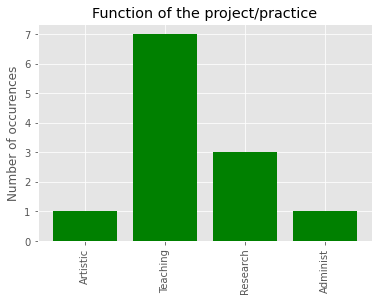
Figure 2 shows how most of the practices are related to Teaching activities in the institutions. Artistic, Research and Administration practices are less frequent. This may reflect the reality or may be biased due to the fact that the call for participation was mainly distributed to teachers and not advertised to students or administrative staff.
Access to the project/practice
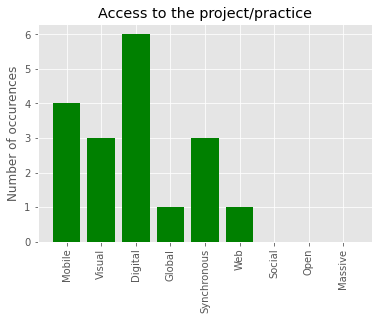
Figure 3 shows how Digital practices are mainly Synchronous and accessible through the Web from any device connected to the Internet, and with an important Visual component. These practices are not thought to be Massive, Global or Open. In general terms, the reported practices are somehow closed initiatives, addressing a few (or medium) number of participants.
Social role of the project/practice
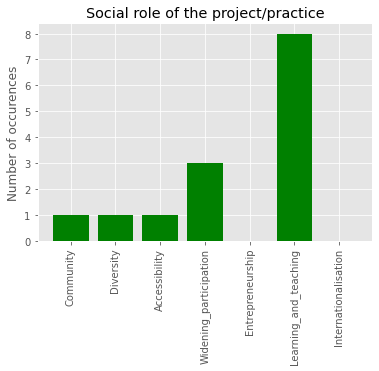
Figure 4 shows how most of the practices in the institutions are focused on their own educational tasks. In fact, there is a scarcity of practices focused on helping students in relation to Internationalization and Entrepreneurship or aimed at Accessibility, Diversity or Widening participation. This may reflect that many of these practices are led by teachers individually, small teams or some departments of the institution without the overall perspective of the institution. In consequence, students might be doing these tasks by themselves without institutional intervention.
Comparing sets of labels
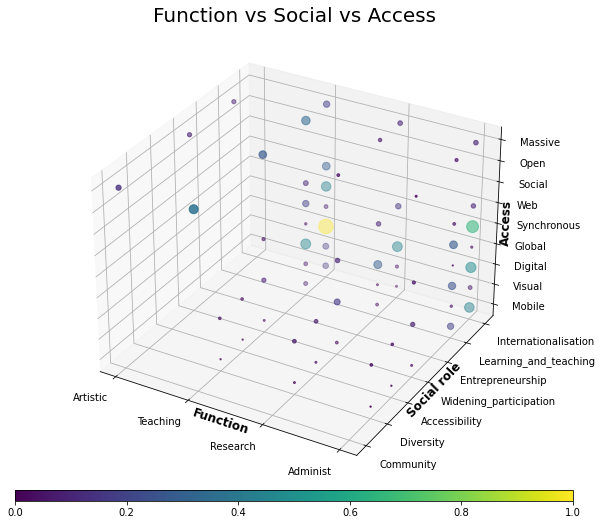
Figure 5 shows all the submitted practices in a 3D space with each axis representing one set of labels. A qualitative comparative analysis allows probing the combinations of labels that occur most or less frequently. This helps to determine which activities are most or less frequently covered by HME institutions in terms of digitalisation.
Function vs Access in the project/practice
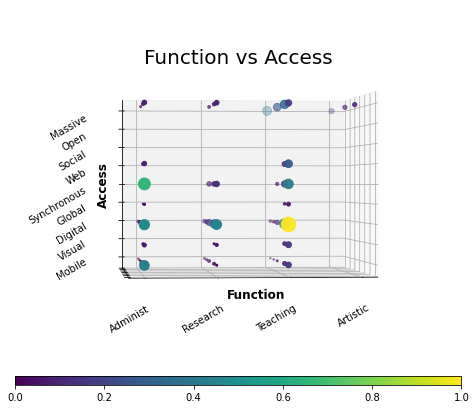
Teaching is the most predominant function of the practices we collected through the questionnaire. As the questionnaire is related to digitisation practices, it was expected that Digital access to technology in teaching activities would be the most predominant combination, as marked by the yellow bubble in Figure 6.
Mobile and Web access to teaching practices are also relevant in contrast to Open and Global access, which are the less frequent labels in this context. This behaviour is repeated throughout the other functions beyond the Teaching one.
In consequence of this, we propose Question 1 for a future debate: Should HME institutions share their knowledge and digital practices with the global society under the Open Knowledge movement?
On the other hand, Artistic and Research functions are covered less in the compiled projects with respect to Teaching and Administrative . A priori, this is not bad but we can propose Question 2 for further enquiry: Should HME institutions, as they are “universities of music”, make an effort in promoting and supporting artistic creation and research, at least, at the same level of teaching activities?
Function vs Social role of the project/practice
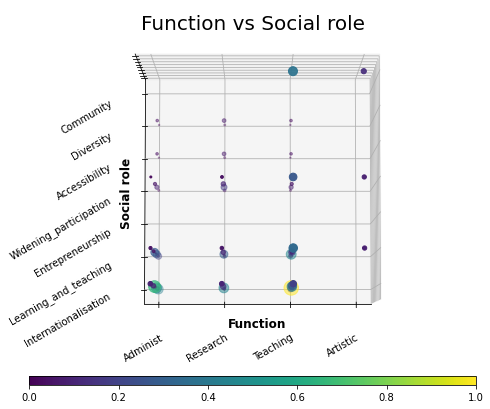
Here again, Teaching and Administrative initiatives are shown as the most predominant functions collected in the questionnaire, as presented in the previous section. From the Social point of view, Figure 7 shows Internationalisation and Learning and Teaching, followed by the Community, as the roles stated by participants. However,, there are not a significant number of practices related to Diversity nor Entrepreneurship. This leads us to propose Question 3: Should HME institutions focus more on entrepreneurship, and also in diversity owing to the infinite possibilities of digital technologies?
Access vs Social role of the project/practice
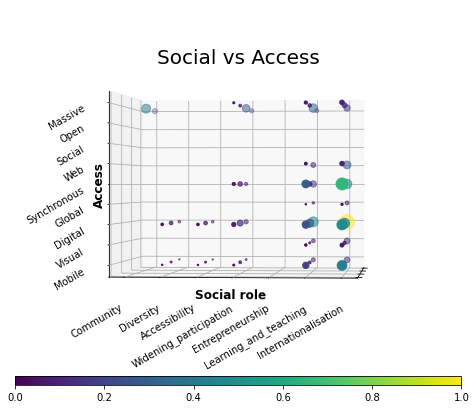
Finally, Figure 8 shows the third view of the three proposed sets of labels for categorisation. As described in the previous sections, most of the proposed initiatives have Web, Mobile and/or Digital access to the practice, and these practices are mainly related to Learning and Teaching and Internationalisation social roles. But what is interesting here is the lack of initiatives related to Entrepreneurship and Diversity that have Global and/or Open access, which is a core goal for the SMS project. Therefore, Question 4 for future debate is: Should HME institutions focus on open and global practices to support entrepreneurship and inclusive practices?
Discussion
In the previous sections, we presented the collected results from the categorization schemes proposed in the questionnaire in a 3DCube graphical view, and debated about each of the three combinations of categorization schemes in a 2D view. As discussed above, we propose four questions for a future debate beyond the analysis of the data itself:
- Should HME institutions share their knowledge and digital practices with the global society under the Open Knowledge movement?
- Should HME institutions, as they are “universities of music”, make an effort in promoting and supporting artistic creation and research, at least, at the same level of teaching activities?
- Should HME institutions focus more on entrepreneurship, and also in diversity owing to the infinite possibilities of digital technologies?
- Should HME institutions focus on open and global practices to support entrepreneurship and inclusive practices?
By summarizing the previous questions, and by being mindful of the SMS project, and one of its main objectives being the role of HME institutions in society, we propose the ultimate question to those responsible for HME policy-making:
- Should HME institutions promote Research into Open and Global practices related to Entrepreneurship and Diversity/Inclusivity to achieve a relevant role in society?
At this point, the answer to this questions remains inconclusive. However, we can state that there are many exemplary initiatives that must go beyond their own institution or area of knowledge. Also, the questionnaire shows some weaknesses of higher musical education policies in terms of motivation and support to some initiatives proposed (or carried out) by the HME institutions.
Conclusions
In this post, we have shown the collected results from the questionnaire on digitisation activities in HME institutions published in September 2019, in the context of the SMS project.
First of all, it is worth mentioning these answers are collected in a pre COVID-19 situation. They show a picture of digitisation activities carried out in HME institutions, and we discussed which were the most and least covered scenarios. In fact, it would be interesting to repeat a project like this in order to compare the evolution of the digitisation state post COVID-19.
Nevertheless, collected data shows a lack of activity in some important aspects that may define the role of HME institutions as social builders, such as the promotion of research and artistic creation through the use of IT, the adoption of the Open Knowledge principles, and more efforts on entrepreneurship and diversity/inclusivity related initiatives.
Bibliography
- Ruippo, M. 2018. Use of Technology in Music Schools. Digitisation in European Music Schools. European Music School Discussion Platform. Sneek, Netherlands. 9.5.2018.